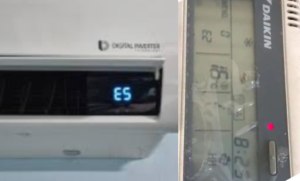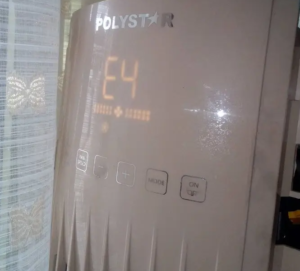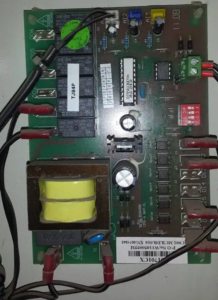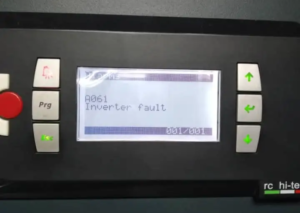Air conditioning systems are complex machines that work tirelessly to keep our living and working spaces cool and comfortable. However, like any mechanical system, they can occasionally encounter issues and malfunction. When this happens, it can be frustrating and inconvenient for users.
To help identify and troubleshoot these issues, air conditioning systems are equipped with error codes. These codes act as a diagnostic tool, providing valuable information about the specific problem that the system may be experiencing. Understanding these error codes is essential for homeowners, technicians, and anyone responsible for maintaining or repairing air conditioning systems.
Error codes are typically displayed on the control panel or thermostat of the air conditioning unit. Each code corresponds to a specific fault or malfunction and is usually accompanied by a brief description of the problem. By referring to the error code, users can quickly determine the nature of the issue and take appropriate action.
Some common error codes in air conditioning systems might indicate problems such as low refrigerant levels, faulty sensors, compressor issues, or electrical faults. It’s important to note that error codes can vary depending on the make and model of the air conditioning system. Therefore, it’s crucial to consult the manufacturer’s manual or contact a professional technician for accurate interpretation and resolution.
Common types of error codes and their meanings
When your air conditioner encounters an issue, it often displays an error code on the control panel. These codes are designed to provide valuable information about the problem at hand, enabling you to take appropriate action.
One common error code is the E1 code, which typically indicates a problem with the air filter. This error message reminds you to clean or replace the air filter to ensure proper airflow and prevent potential damage to the system. Another frequently encountered code is E2, which signifies a malfunction in the outdoor temperature sensor. This error may cause the system to behave erratically or fail to maintain the desired temperature.
If you come across an E3 code, it indicates an abnormal communication error between the indoor and outdoor units. This could be due to a faulty connection or wiring issue, requiring professional assistance to diagnose and resolve. On the other hand, an E4 code often points to a refrigerant leak, which should be addressed promptly by a qualified technician to avoid further damage to the system.
Additionally, an F1 or F2 code typically indicates a problem with the indoor or outdoor fan motor, respectively. These errors could be caused by a variety of issues, including motor failure, loose wiring, or a blocked fan blade. It is essential to address these errors promptly to prevent overheating and potential system breakdown.
It’s important to note that diagnosing and repairing complex air conditioning problems should be left to trained technicians to ensure safety and prevent further damage to the system.
Error code troubleshooting
When you come across an error code, the first step is to consult your air conditioning system’s manual. This manual is like your trusty guidebook that provides valuable information about the different error codes and their corresponding solutions. It will outline the specific steps you need to take to resolve the issue.
In some cases, the error code may indicate a simple fix that you can handle on your own. For example, a common error code is “E1” which typically indicates a clogged air filter. In this situation, you can simply clean or replace the air filter to restore proper functionality to your unit.
However, there are instances where the error code may indicate a more complex problem that requires professional assistance. It’s important to know your limits and when it’s best to call in a qualified HVAC technician. They have the experience and expertise to diagnose and repair the underlying issue effectively.
If you’re confident in your troubleshooting skills and want to attempt to fix the problem yourself, be sure to follow the necessary safety precautions. Always turn off the power to your air conditioning system before attempting any repairs or maintenance.
Remember, error codes are designed to help you identify and address issues with your air conditioning system. By familiarizing yourself with these codes and their troubleshooting steps, you can navigate through the mystery of error codes and keep your system running smoothly and efficiently.
Specific error codes and their implications
Error codes serve as valuable diagnostic tools that provide insights into the underlying problems that your AC unit may be experiencing.
Each error code corresponds to a specific issue or malfunction within the system. By deciphering these codes, you can gain a better understanding of what is causing the problem and take appropriate actions to rectify it.
For instance, an error code such as E1 might indicate a problem with the air filter. This could mean that the filter is dirty or clogged, leading to reduced airflow and inefficient cooling. In such a case, cleaning or replacing the air filter can help restore optimal performance.
Another common error code is E2, which could signify issues with the condenser or outdoor unit. This might indicate problems like a faulty fan motor, low refrigerant levels, or a malfunctioning compressor. Identifying and addressing these issues promptly can prevent further damage to the system and ensure efficient cooling.
It is important to consult the manufacturer’s manual or reach out to a professional technician to get accurate information on the error codes specific to your air conditioning system. They can provide detailed explanations and guidance on the necessary steps to resolve each error code effectively.
By familiarizing yourself with the error codes and understanding their implications, you can save time, money, and frustration by quickly identifying and addressing issues in your air conditioning system. Regular maintenance and prompt troubleshooting based on error codes can help ensure optimal performance and extend the lifespan of your AC unit.
How to reset error codes in air conditioning systems
Many error codes can be easily resolved by simply resetting the system. Here are some simple steps to help you reset error codes in your air conditioning system:
1. Locate the control panel: The control panel is usually found on the front of your air conditioning unit or on the remote control. It may have buttons or a touchscreen display.
2. Identify the reset button: Look for a button labeled “Reset” or a small hole that requires a pin or paperclip to reset the system. If you’re unsure, consult your air conditioning system’s user manual for specific instructions.
3. Turn off the power: Before resetting the system, it’s crucial to turn off the power supply to your air conditioner. This can be done by switching off the circuit breaker or unplugging the unit from the power source.
4. Press and hold the reset button: If your system has a reset button, press and hold it for a few seconds. If there’s a small hole, use a pin or paperclip to press and hold the reset button inside the hole. Keep holding the button until you see the display on the control panel change or hear a beep sound.
5. Release the reset button: Once you’ve held the reset button for the appropriate amount of time, release it and wait for the system to reboot. This may take a few moments, so be patient.
6. Check for error code disappearance: After the system has rebooted, check the control panel for any error codes. If the error code has disappeared, congratulations! You have successfully reset the system. If the error code persists, you may need to consult a professional technician for further assistance.
Remember, resetting the system only clears temporary error codes. If the error code reoccurs frequently, it could indicate an underlying issue that requires professional attention. It’s always recommended to consult a certified HVAC technician for complex problems or if the error codes persist.
Preventive measures to avoid error codes
Preventing error codes in your air conditioning system is crucial to ensure its smooth operation and avoid any inconvenient breakdowns. By taking some simple preventive measures, you can significantly reduce the chances of encountering error codes.
First and foremost, regular maintenance is essential. Schedule professional inspections and tune-ups for your air conditioning system at least once a year. During these inspections, a trained technician will thoroughly clean and inspect the various components of your system, identify any potential issues, and make necessary repairs or adjustments. This proactive approach can help catch minor problems before they escalate into major malfunctions that trigger error codes.
Another preventive measure is to regularly clean or replace your air filters. Clogged or dirty filters can restrict airflow and strain the system, leading to error codes and reduced efficiency. Check your filters monthly and clean or replace them as needed. This simple step can not only prevent error codes but also improve indoor air quality and prolong the lifespan of your air conditioning system.
Maintaining proper airflow around your air conditioning unit is also crucial. Make sure that there are no obstructions, such as furniture or curtains, blocking the vents or obstructing the outdoor unit. Adequate airflow allows the system to function optimally and reduces the likelihood of error codes.
Furthermore, be mindful of the ambient temperature and humidity levels in the areas where your air conditioning system is installed. Extreme temperatures or excessive humidity can put additional strain on the system and potentially trigger error codes. Consider using shades or curtains to minimize direct sunlight and using dehumidifiers to control humidity levels if necessary.
Lastly, educate yourself about your specific air conditioning system and its error codes. Read the manufacturer’s manual and familiarize yourself with the meaning of each error code. This knowledge can help you identify and address minor issues on your own or promptly communicate the problem to a professional technician.
Importance of professional help for complex error codes
There are instances when error codes can be complex and require professional expertise to decode and fix.
Complex error codes often indicate underlying problems that may require specialized knowledge and tools to diagnose and repair. Attempting to resolve these issues without the necessary skills and experience can lead to further damage to the system, resulting in costly repairs or even the need for a complete replacement.
By seeking professional help, you can ensure that the error codes are accurately interpreted and appropriate actions are taken. HVAC technicians have the training and expertise to identify the root cause of the error code, whether it’s a faulty component, a wiring issue, or a more complex system malfunction.
Moreover, professional technicians have access to diagnostic tools and equipment specifically designed for troubleshooting air conditioning systems. These tools enable them to pinpoint the exact problem quickly and efficiently, saving you time and frustration.
Additionally, relying on professional help for complex error codes ensures that any repairs or replacements are done in accordance with manufacturer guidelines and industry standards. This helps to maintain the warranty of your air conditioning system and ensures optimal performance and longevity.
Tips for maintaining your air conditioning system to prevent error codes
Regular maintenance of your air conditioning system is crucial to prevent error codes from occurring. By following these tips, you can keep your AC system in top shape and avoid unexpected breakdowns.
1. Clean or replace the air filters: Clogged air filters can restrict airflow, leading to strain on the system and potential error codes. Regularly cleaning or replacing the filters ensures proper airflow and helps maintain the efficiency of your AC.
2. Keep the outdoor unit clean: The outdoor unit of your AC system can accumulate dirt, leaves, and debris over time. This can obstruct the airflow and cause the system to overheat, triggering error codes. Keep the area around the unit clean and remove any obstructions regularly.
3. Check and clean the condenser coils: Dirty condenser coils can reduce the cooling capacity of your AC and put stress on the system. Inspect the coils for any dirt or debris buildup and clean them using a soft brush or a vacuum cleaner.
4. Maintain proper refrigerant levels: Low refrigerant levels can cause your AC system to malfunction and display error codes. Regularly check the refrigerant levels and if necessary, consult a professional technician to recharge or repair any leaks.
5. Inspect and clean the evaporator coils: The evaporator coils inside your AC unit can become dirty and affect the cooling process. Carefully clean the coils using a soft brush or a coil cleaner solution to ensure efficient cooling and prevent error codes.
6. Keep the condensate drain clean: The condensate drain removes moisture from your AC system. Over time, it can become clogged with dirt and debris, leading to water leakage and potential error codes. Regularly inspect and clean the condensate drain to prevent any blockages.
7. Schedule professional maintenance: It’s essential to have your air conditioning system professionally inspected and maintained at least once a year. A trained technician can identify any potential issues, clean the system thoroughly, and ensure optimal performance, reducing the chances of error codes.
Frequently asked questions about error codes in a air conditioning systems
When it comes to error codes in air conditioning systems, it’s natural to have questions. These codes can be confusing and frustrating, especially if you’re not familiar with the inner workings of your AC unit. To help clear up any confusion, we’ve compiled some frequently asked questions about error codes in air conditioning systems:
Q: What do error codes in air conditioning systems mean?
A: Error codes are numerical or alphanumeric combinations displayed on the control panel of your air conditioning unit. These codes indicate specific issues or malfunctions within the system. Understanding these codes can help diagnose and troubleshoot problems more effectively.
Q: How can I find the meaning of an error code?
A: The meaning of error codes can vary depending on the make and model of your air conditioning system. Consult the manufacturer’s manual or documentation for a comprehensive list of error codes and their corresponding explanations. In some cases, you may need to contact the manufacturer or a professional HVAC technician for assistance.
Q: Can I reset an error code on my own?
A: In some cases, resetting an error code may temporarily resolve the issue. However, it’s important to address the underlying problem causing the error code. Simply resetting the code without proper diagnosis and repair can lead to recurring issues or further damage to the system. It’s best to consult a qualified HVAC technician to identify and fix the root cause of the error code.
Q: Are all error codes the same across different air conditioning brands?
A: No, error codes can vary between different air conditioning brands and models. It’s crucial to refer to the specific manufacturer’s documentation or seek professional advice when interpreting and troubleshooting error codes.
Q: Should I attempt to fix an error code myself?
A: While some error codes may have simple solutions, such as cleaning or replacing filters, it’s generally recommended to leave complex repairs to professionals. HVAC systems are complex and delicate, and attempting to fix an error code without proper knowledge and expertise can lead to further damage or safety hazards. It’s always best to consult a qualified technician for accurate diagnosis and repair.
In conclusion, understanding and addressing error codes in air conditioning systems is of utmost significance for both homeowners and HVAC professionals. These error codes serve as valuable diagnostic tools that provide vital information about the system’s functionality and potential issues.
By familiarizing yourself with the error codes specific to your air conditioning unit, you can quickly identify the root cause of any problem and take appropriate action. This knowledge can save you time and money by avoiding unnecessary service calls and repairs.
Addressing error codes promptly is crucial to prevent further damage to the system. Ignoring or neglecting these codes can lead to more severe malfunctions, reduced efficiency, and even complete system failure. By taking immediate action and seeking professional assistance, you can mitigate the risks and prolong the lifespan of your air conditioning unit.
For HVAC professionals, a thorough understanding of error codes is essential for providing accurate and efficient service. By quickly deciphering error codes, technicians can diagnose problems more effectively, saving time and improving customer satisfaction. Moreover, an in-depth knowledge of error codes enables professionals to recommend appropriate maintenance practices, preventing potential issues before they arise.




